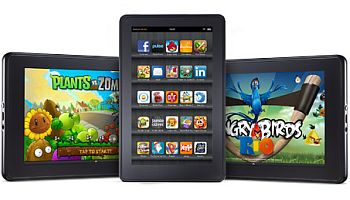Amazon’s Kindle Fire Catching Up To iPad

Amazon’s Kindle Fire is developing into the first real competitor to Apple’s iPad, according to market predictions
Amazon’s Kindle Fire will ship 3.9 million units in the last quarter of this year, according to a December 2 note from research firm IHS. That will give it 13.8 percent of global media tablet shipments for the quarter, placing it behind Apple’s iPad.
“A competitor has finally developed an alternative which looks like it might have enough of Apple’s secret sauce to succeed,” Rhoda Alexander, senior manager of tablet and monitor research for HIS, said. “The production plans make it clear that Amazon is betting big on the product.”
Fire success
 In the firm’s estimation, Samsung’s Galaxy Tab franchise came in third behind the Kindle Fire and iPad, with some 4.8 percent of global media tablet shipments.
In the firm’s estimation, Samsung’s Galaxy Tab franchise came in third behind the Kindle Fire and iPad, with some 4.8 percent of global media tablet shipments.
Thanks to the predicted success of the Fire, IHS has upped its previous estimate for 2011 tablet shipments by 7.7 percent to 64.7 million units. That represents 273 percent growth from the 17.4 million units that shipped in 2010.
A recent IHS teardown placed the Kindle Fire’s manufacturing cost at $201.70. If that analysis holds, it means that Amazon racks up a slight but noticeable loss every time someone purchases a Fire for $199.
“Amazon makes its money not on Kindle hardware, but on the paid content and other products it plans to sell the consumer through the Kindle,” Andrew Rassweiler, senior director of IHS’ teardown services, wrote in an 18 November research note.
Storefront links
“This is a similar business model to wireless companies such as AT&T or Verizon. They sell you a phone that costs them $400 (£256) to $600 or more to make for a price of only $200. However, they expect to more than make up for that loss with a two-year service contract.”
That differs from the strategies of other tablet manufacturers, who may rely far more on margins from the devices themselves than any sort of electronic storefront.
In order to facilitate purchases, the Kindle Fire’s user interface centres on a series of tabs (such as “books”) that open immediately onto Amazon’s online storefront.
In that spirit, the Kindle Fire is designed explicitly as a consumer device, not a business one. That could deny Amazon the corporate audience that has increasingly gravitated toward not only Apple’s iPad, but also its Android- and QNX-based rivals.